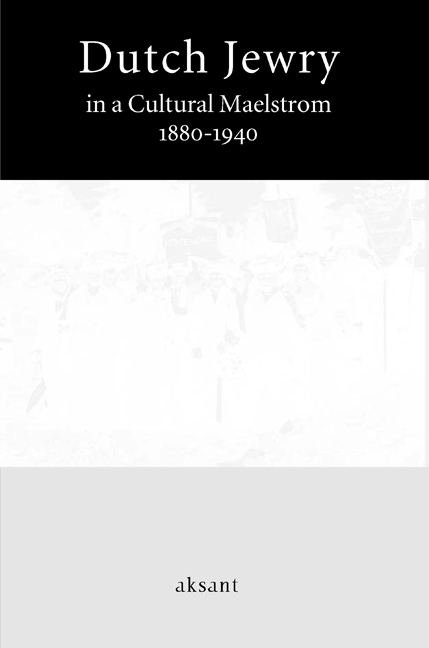Book contents
- Frontmatter
- Contents
- Foreword
- The New “Mosaik”: Jews and European Culture, 1750-1940
- The Politics of Jewish Historiography
- “The First Shall be the Last”: The Rise and Development of Modern Jewish Historiography in the Netherlands Until 1940
- Epigones and Identity: Jewish Scholarship in the Netherlands, 1850-1940
- Judaism on Display: The Origins of Amsterdam's Jewish Historical Museum
- De Vrijdagavond as a Mirror of Dutch Jewry in the Interbellum, 1924-1932
- “Holland is a Country which Provokes Serious Reflection…”: Images of Dutch Jewry in the German Jewish Press
- Spinozism and Dutch Jewry between 1880 and 1940
- Spinoza's Popularity in Perspective: A Dutch-German Comparison
- Mozes Salomon Polak: Jewish “Lerner” and Propagator of Freemasonry, Spiritualism, and Theosophy
- Jewish Women, Philanthropy, and Modernization: The Changing Roles of Jewish Women in Modern Europe, 1850-1939
- Roosje Vos, Sani Prijes, Alida de Jong, and the others: Jewish Women Workers and the Labor Movement as a Vehicle on the Road to Modernity
- Stemming the Current: Dutch Jewish Women and the First Feminist Movement
- Dutch Jewish Women: Integration and Modernity
- Index of Names of Persons
- Index of Subjects
Stemming the Current: Dutch Jewish Women and the First Feminist Movement
Published online by Cambridge University Press: 26 January 2021
- Frontmatter
- Contents
- Foreword
- The New “Mosaik”: Jews and European Culture, 1750-1940
- The Politics of Jewish Historiography
- “The First Shall be the Last”: The Rise and Development of Modern Jewish Historiography in the Netherlands Until 1940
- Epigones and Identity: Jewish Scholarship in the Netherlands, 1850-1940
- Judaism on Display: The Origins of Amsterdam's Jewish Historical Museum
- De Vrijdagavond as a Mirror of Dutch Jewry in the Interbellum, 1924-1932
- “Holland is a Country which Provokes Serious Reflection…”: Images of Dutch Jewry in the German Jewish Press
- Spinozism and Dutch Jewry between 1880 and 1940
- Spinoza's Popularity in Perspective: A Dutch-German Comparison
- Mozes Salomon Polak: Jewish “Lerner” and Propagator of Freemasonry, Spiritualism, and Theosophy
- Jewish Women, Philanthropy, and Modernization: The Changing Roles of Jewish Women in Modern Europe, 1850-1939
- Roosje Vos, Sani Prijes, Alida de Jong, and the others: Jewish Women Workers and the Labor Movement as a Vehicle on the Road to Modernity
- Stemming the Current: Dutch Jewish Women and the First Feminist Movement
- Dutch Jewish Women: Integration and Modernity
- Index of Names of Persons
- Index of Subjects
Summary
At the start of the twentieth century, life in the Netherlands continued to be as tempestuous as it had been since the second half of the nineteenth century. The demographic transition characterized by a steep decline in the mortality rate followed by a gradual decline in the fertility rate led to a rapid growth in population. This altered the composition of the citizenry irreversibly by introducing the demographic pattern of the modern family with two or three children and a keen awareness of family planning. Industrialization and economic growth resulted in increasing prosperity that for once did not completely pass over the lower social classes. The estate-based social framework slowly gave way to a more open class structure. Politics evolved from a pleasant (and profitable) pursuit of the upper classes into a means of power and a common right of the middle and lower classes. Being able to address the crowd and win the vote demanded techniques we now recognize to be characteristic of mass organizations. Far-reaching cultural influences like scientific innovation and radical artistic trends complete the image of a society turned topsyturvy.
All Western European countries underwent this dramatic development, and in all these countries the societal realization that the assumed way of life of pre-industrial society was over and forever done with resulted in widespread bewilderment and a desire for a redefinition of social identity. In the Netherlands, the powerful influence of competing Christian denominations and political ideologies guided this sense of loss to what we now call pillarization – the compartmentalization of social, economic, political and cultural life along religious and ideological lines. From maternity nursing and primary school, to leisure organizations and trade unions: all was organized individually by each religious denomination or ideological group – be it Protestant, Catholic, Socialist, or Liberal. In this way, pillarization worked as a kind of social filter. The different pillars guided their members through the demographic, socio-economic, political, and cultural transformations of the early twentieth century.
One of the social movements contributing to the chaotic climate of the time was the women's movement. In Europe, the first feminist movement evolved in the second half of the nineteenth century. Little by little, women started to unite in order to change some aspects of their social position, which was unequal to that of men in economic, legal, political, educational, and cultural spheres.
- Type
- Chapter
- Information
- Dutch Jewry in a Cultural Maelstrom, 1880-19401880-1940, pp. 169 - 182Publisher: Amsterdam University PressPrint publication year: 2008

